|
|
|
Sort Order |
|
|
|
Items / Page
|
|
|
|
|
|
|
| Srl | Item |
| 1 |
ID:
127778
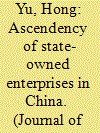

|
|
|
|
|
| Publication |
2014.
|
| Summary/Abstract |
The state sector still plays an important role in China's economy. One of the key development phenomena characterizing the Chinese economy is the rapid ascendency of state-owned enterprises (SOEs) and the resurgence of the state. The strength of China's SOEs is projected in the centrally administrated state-owned enterprises (CSOEs). They are the backbone of the national economy, spearheading national economic development and Beijing's 'going-out' strategy. The CSOEs have expanded their reach and increased their power, domestically and globally. In seeking to boost local GDP growth, the eastern provinces in China have joined the western provinces in a fierce contest to attract investment from SOEs. Nevertheless, the rapid ascendency of the SOEs has brought many negative consequences for China's economic, social and political development by causing conflict with the market-oriented development direction of Chinese economic reform and hindering fair competition between state-owned and non-state-owned enterprises.
|
|
|
|
|
|
|
|
|
|
|
|
|
|
|
|
| 2 |
ID:
129535
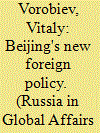

|
|
|
|
|
| Publication |
2014.
|
| Summary/Abstract |
All players expect explanation from China of its initiative to build a New Economic Silk Road. The faster it presents arguments and the clearer they are, the less room there will be for idle speculation and rumor. In any case, China is interested in a favorable response and support for its own foreign policy signals. Chinese leader Xi Jinping first came up with the idea of creating a Silk Road economic space as foreign policy priority for the current, fifth generation of national leaders during a visit in September 2013 to Kazakhstan. In view of the crucial and long-term character of his intention, it is in Russia's interests, as a European and Pacific power and as China's neighbor and long-term bilateral strategic partner, to take a closer look at what content China is putting into this newly conceived project and how the Asian power plans to implement it.
|
|
|
|
|
|
|
|
|
|
|
|
|
|
|
|
| 3 |
ID:
130610
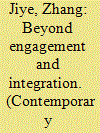

|
|
|
|
|
| Publication |
2014.
|
| Summary/Abstract |
As part of its new strategy of "retuming to the Asia-Pacific region", the A Obama administration has adopted some tough economic policies towards China, notably promoting the Trans-Paci?c Partnership (TPP) and attempting to establish new rules of international trade and investment aimed at strengthening economic ties with other Western countries through the Trans-Atlantic Trade and Investment Partnership Agreement(TTlP ), both of which tend to compress the geopolitical space for China's economic rise. The administration is also using a 'green barrier' to suppress the development of China's high-tech industry, and using economic diplomacy and investment restrictions against Chinese state-owned enterprises. This paper seeks to examine and analyze the causes of shifts in the U .S. economic strategy towards China.
|
|
|
|
|
|
|
|
|
|
|
|
|
|
|
|
| 4 |
ID:
130943
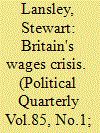

|
|
|
|
|
| Publication |
2014.
|
| Summary/Abstract |
Is 'predistribution' as championed by Ed Miliband, or old fashioned 'redistribution' as adopted, if stealthily, by Labour from 1997, the best way to create greater equality? Some critics have argued that a strategy of predistribution-aimed at closing the income gap before the application of taxes and benefits-would not work and that it will be necessary to rely mainly on redistribution. This article examines the potential impact of weak and more radical predistribution-style measures on one of the key drivers of inequality-'wage compression'. It examines the potential of a mix of policies for raising the wage floor. It argues that reliance on traditional redistribution would face its own set of constraints and that creating a more equal distribution of the cake, before taxes and benefits, is a necessary condition for lowering the risk of continuing economic crisis.
|
|
|
|
|
|
|
|
|
|
|
|
|
|
|
|
| 5 |
ID:
124989
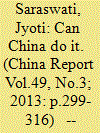

|
|
|
|
|
| Publication |
2013.
|
| Summary/Abstract |
Since the turn of the century the Chinese state has endeavoured to establish an internationally competitive, export-oriented software services industry centred on large domestic firms. However, despite concerted targeting and significant state investment, the industry's size and capabilities have fallen further behind those in peer competitor countries, particularly India. The article assesses the progress of the industry in China and examines how this relates to the PRC's software strategy. It does so by adopting a comparative analysis approach, evaluating the PRC's policy agenda and the axioms underpinning it in light of emerging research on the processes and mechanisms behind the more successful development of the software services industry in India. The article concludes by arguing that the PRC needs to make several substantive changes to its software strategy if it is to achieve its objectives
|
|
|
|
|
|
|
|
|
|
|
|
|
|
|
|
| 6 |
ID:
128117
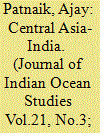

|
|
|
|
|
| Publication |
2013.
|
| Summary/Abstract |
Revival of the 'Silk Road' or Silk Road Strategy is a fashionable terms now days, even in Indian academic circles. Of course the word has been used more extensively by American and Chinese scholars. This began with the US Silk Road Strategy act of 1999, which talked of transporting the Central Asian region's natural resources to the international market.
|
|
|
|
|
|
|
|
|
|
|
|
|
|
|
|
| 7 |
ID:
130377
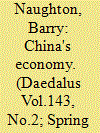

|
|
|
|
|
| Publication |
2014.
|
| Summary/Abstract |
China's economic success has bred a new complacency and resistance to change. This in turn has created a credibility crisis, as many Chinese citizens believe the opposition of vested interests makes reform impossible. However, proponents of economic reform argue that the current economic strategy is unsustainable. They point to reform backsliding, overinvestment, and financial fragility as problems that will collide with an inevitable economic slowdown caused by rapid demographic changes, and that will potentially cause economic and political crisis. Renewed economic reform is thus the only prudent and viable choice. The November 2013 Third Plenum shows that China's leaders have tentatively accepted the need for reform.
|
|
|
|
|
|
|
|
|
|
|
|
|
|
|
|
| 8 |
ID:
130648


|
|
|
|
|
| Publication |
2013.
|
| Summary/Abstract |
The committee's report has highlighted the diversity of the countries of the Indian Ocean Rim and the multiple ways it which these states can be categorised. This diversity and the lack of a single agreed definition of the 'Indian Ocean Rim' has created a significant challenge for the development of policy, from both an Australian and a regional perspective. Australia's approach to trade in the Indian Ocean Rim is largely bilateral; defence and strategic relations are based on single issue groupings; and aid to the region is predominately provided under the auspices of the United Nations. Evidence gathered in relation to the Indian Ocean Rim Association for Regional Co-operation (IOR-ARC) demonstrates clearly that diversity in the region - both economic and political - has created inertia in the region's main organisation.
|
|
|
|
|
|
|
|
|
|
|
|
|
|
|
|
| 9 |
ID:
132325


|
|
|
|
|
| Publication |
2014.
|
| Summary/Abstract |
This article examines compliance with international laws prohibiting the intentional targeting of noncombatants in interstate war, specifically focusing on the role of third-party states in enforcement. We argue that the expectation of third-party coercion, when sufficiently high, can induce war participants to comply with this body of law. We identify the conditions under which combatant states will anticipate a high likelihood of coercion, demonstrating that third-party states are most likely to coerce combatants when they have both the willingness and opportunity to do so. Democratic third parties that value the rule of law and human rights possess the willingness to coerce war participants, while strong allies, trade partners, and intergovernmental organization (IGO) partners with existing ties to the combatant state have the opportunity to engage in coercion by linking combat-ant behavior to the provision of benefits or imposition of costs. Based on this logic, we hypothesize that war combatants who have ratified the Geneva/Hague Conventions prohibiting the intentional targeting of noncombatants during war are more likely to comply with the legal obligations included in those conventions when they interact with relatively strong democratic alliance, trade, and IGO partners. In a series of quantitative tests on a data set of all interstate wars from 1900 to 2003, we find strong statistical and substantive support for the role of third parties in inducing compliance with the law.
|
|
|
|
|
|
|
|
|
|
|
|
|
|
|
|
| 10 |
ID:
127582
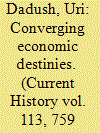

|
|
|
|
|
| Publication |
2014.
|
| Summary/Abstract |
The economic convergence of large parts of the developing world with the advanced nations is the great story of our time. Sixty years ago, Singapore was an impoverished, malaria-infested island whose future absolute ruler, Lee Kuan Yew, admired the prosperity and civilization of the United Kingdom, where he had been educated. Singapore's per capita income has since surpassed that of the UK and the rest of Europe by a wide margin and, more recently, that of the United States. Today, one in six households in Singapore has more than $1 million in disposable assets. And as its extraordinarily rapid economic development progressed, Singapore converged with the advanced nations in other ways: by rooting out endemic corruption, adopting strict environmental standards, and making progress toward a more pluralistic and democratic society.
|
|
|
|
|
|
|
|
|
|
|
|
|
|
|
|
| 11 |
ID:
128316
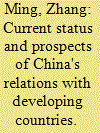

|
|
|
|
|
| Publication |
2013.
|
| Summary/Abstract |
In the 21st century, developing countries have become a pivotal force in the world, with rapid development, growing strength, and rising international status and influence. As the largest developing country, China has always considered developing countries as a foundation of its diplomacy. As China presses ahead with the times, its relations with developing countries have yielded fruitful results. The interests of China and other developing countries have become increasingly interconnected, hence the growing need for each other. Developing countries generally have a stronger desire to strengthen cooperation with China. China's relations with developing countries face new opportunities.
|
|
|
|
|
|
|
|
|
|
|
|
|
|
|
|
| 12 |
ID:
132317
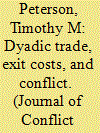

|
|
|
|
|
| Publication |
2014.
|
| Summary/Abstract |
Most studies of the link between dyadic trade and militarized conflict examine the extent of trade interaction. However, interaction measures do not account for the impact of cutting off trade (i.e., exit costs). In this article, I highlight the link between exit costs, the cost of conflict, and "the spoils of conquest," arguing that one state's exit costs are associated with higher incidence of dyadic conflict when its trade partner's exit costs are low. However, its exit costs become less aggravating-and eventually pacifying-as its trade partner's exit costs increase. I test this argument by estimating import demand and export supply elasticities, developing yearly exit cost measures for directed dyads, 1984-2000. Statistical tests confirm that unilaterally high exit costs are aggravating, but that jointly high exit costs are pacifying, a pattern most prominent for trade in strategic commodities.
|
|
|
|
|
|
|
|
|
|
|
|
|
|
|
|
| 13 |
ID:
127902
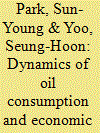

|
|
|
|
|
| Publication |
2014.
|
| Summary/Abstract |
This study attemps to investiagte the causal relationship between oil consumption and economic growth in Malaysia where oil consumption and real gross domestic product have been rapidly increased in recent years. To this end, the study employs annual data covering the period 1965-2011. Tests for unit roots, co-integration, and Granger-causality based on the error-correction models are presented. The overall results support the existence of bi-directional causality between oil consumption and economic growth in Malaysia. This means that an increase in oil consumption directly affect economic growth. Thus, in order not to make an adverse effect on economic growth, Malaysia should endeavor to overcome the constraints on oil consumption. Moreover, it appears that economic growth induces oil consumption
|
|
|
|
|
|
|
|
|
|
|
|
|
|
|
|
| 14 |
ID:
131391


|
|
|
|
|
| Publication |
2014.
|
| Summary/Abstract |
East Asia now occupies a prominent place in the study of international relations (IR). This, of course, does not mean that IR scholarship in the past failed to pay due attention to East Asia. Wars, trade, and international integration in this region have been the subject of analysis in countless books and scholarly articles. However, the renewed interest in this region is not so much empirically driven (to increase East Asian coverage in the literature) as before but rather represents a theoretical inquiry pertinent to the intellectual underpinning of the scholarship itself. Today, some experts of the region harshly criticize the 'euro-centric' bias of existing IR study and seek to provide alternative conceptions based on the East Asian experience.1 In response, other scholars have advanced views less provocative but more nuanced about the originality of East Asia. And, there are still others who flatly reject the connotation that the logic of East Asian international relations is inherently different from that elsewhere. Thus, a diverse set of perspectives has been laid out on the table, but their strengths and shortcomings are yet to be evaluated systematically.
|
|
|
|
|
|
|
|
|
|
|
|
|
|
|
|
| 15 |
ID:
128823
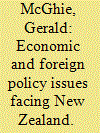

|
|
|
| 16 |
ID:
129476
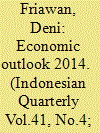

|
|
|
|
|
| Publication |
2013.
|
| Summary/Abstract |
Looking ahead, the outlook in 2014 is expected to see sizeable downside risks, coming from both domestic and external sides. It is estimated that the economic growth in 2014 would remain under 6.0 percent as the country's economy is much more impacted by tighter economic condition, lower commodity prices, as well as uncertainty in financial market and regulatory regime in the run-up to the 2014 election, offsetting the positive effects of global economic recovery and rising spending related national election. Inflation rate, meanwhile, is projected to ease and return to the Bank Indonesia's target band of 4.5:] percent in 2014, as the effect of the effect of the fuel price increases may have subsided and the aggregate demand growth slows.
I however, the recent depreciation in rupiah, the minimum wage hikes for next year, and the second and third-round effects from the increase in fuel prices and electricity billing rates may give further in?ationary pressures to the outlook. As for external side, a modest narrowing in current account deficits is expected to be help by slowing imports, as investment growth continues moderate in 2014.
|
|
|
|
|
|
|
|
|
|
|
|
|
|
|
|
| 17 |
ID:
127206
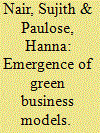

|
|
|
|
|
| Publication |
2014.
|
| Summary/Abstract |
Emergent business models seek to take advantage of new market mechanisms driven by technological changes, particularly those related to the production and delivery of clean or sustainable energy. Such business models often function at the intersection of various industries, with global views, and the resulting systems have distinct social, political, environmental, economic, technological, and business dimensions. Such holistic systems are not only difficult to develop but also require support from a broad range of actors with effective regulations and policies in place, such that the firm functions within a framework that integrates various factors. This study substantiates such a framework by detailing the nascent algae-based bio-fuel industry that caters to the aviation sector while arguing that businesses in the energy industry can emerge as a next-practice platform that drive a sixth wave of innovation. The framework begins with three basic enablers, innovation, flexibility, and sustainability, and explains how value from renewable energy technologies can be created and captured sustainably and innovatively with new market mechanisms implemented by firms with green business models.
|
|
|
|
|
|
|
|
|
|
|
|
|
|
|
|
| 18 |
ID:
129637


|
|
|
|
|
| Publication |
2014.
|
| Summary/Abstract |
The global financial crisis (GFC) and subsequent Eurozone sovereign debt crisis (ESDC) have made reform of the global financial governance regime a priority for governments around the world. Prior to the crisis, neoliberal policies agreed between the European Union and the USA created a financial governance regime based on the principle of free operation of the market through the norms of market self-regulation, equal access to the market, and stability via institutional supervision. How will global financial governance look like after these crises? And what role can the EU and China play in shaping this regime? This article argues that as a result of the GFC and the ESDC, stability is becoming a second principle of global financial governance, along with the free operation of the market. Meanwhile, European and Chinese views regarding the norms, rules, and decision-making procedures designed to implement those principles do not differ as much as they used to. Thanks to interactions at the bilateral and multilateral levels, the EU and China now have knowledge regarding how the other understands the role and characteristics that financial governance should have. This is leading to convergence in some areas and cooperation in others. Concurrently, there are also areas of competition. Analysing all of these is essential to understand how global financial governance might evolve, given the central role that the EU and China now play in this regime.
|
|
|
|
|
|
|
|
|
|
|
|
|
|
|
|
| 19 |
ID:
128841


|
|
|
|
|
| Publication |
2014.
|
| Summary/Abstract |
Germany's highest court stopped short of ruling the European Central Bank's programme to support the euro illegal. Now the European Court of Justice must find a way to make the programme acceptable without making it ineffective.
|
|
|
|
|
|
|
|
|
|
|
|
|
|
|
|
| 20 |
ID:
133886
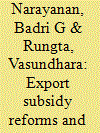

|
|
|
|
|
| Publication |
2014.
|
| Summary/Abstract |
The World Trade Organization (WTO) recommends all members to phase out their export subsidies. While this may render export-oriented industries susceptible to tighter competition in their import markets, productivity improvements could help offset such disadvantages. This article explores the interaction between these two different aspects to evaluate the economy-wide impact of export subsidy reforms and productivity improvements in the Indian textile and clothing sector. Our analysis stands on various policy simulations applying the general equilibrium model of the Global Trade Analysis Project (GTAP; Hertel, 1997). The welfare impacts of the removal of Indian textile and clothing subsidies in terms of equivalent variation shows that India is expected to encounter a loss of about 71.5 million US$, while other Asian countries may gain about 218 million US$. In a different scenario, we simulate the impact of a complete phase-out of subsidies provided to the textile and clothing industry of India and a simultaneous increase in total factor productivity growth to 3.5 per cent. This leads to a net positive welfare change and an expected gain of about US$ 13.17 million in terms of allocative efficiency. We conclude that merely removing subsidies is not enough, as is often argued by Indian policymakers that such a policy reversal might result in contraction of the sector. Investments in total factor productivity should come about simultaneously, probably by employing surplus funds from saved subsidy payments in areas like research and development and infrastructure. This conclusion may be qualitatively generalised for any sector in the world, which is examined for export subsidy reforms, but similar economy-wide studies are recommended for specific cases.
|
|
|
|
|
|
|
|
|
|
|
|
|
|
|
|
|
|
|
|
|